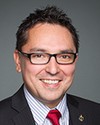We'll get this translated and give it to you, because it's good news. As we explained with the water and waste water, it's now up, and all of these are on the NRCan geomatics site so people can track the projects, whether it's the $275 million for the 201 water and wastewater projects, 965 housing projects, 125 education projects, 167 culture and recreation projects, or 88 energy sustainability and connectivity projects. On fundamental community infrastructure there are 135 projects.
It's really important that we let people know what's happening, and one of the things that's been really important to me is understanding the importance of comprehensive community planning. If the community comes together and decides what it needs and when.... That includes not just the chief and council but the principal, the police chief, the nurse, the youth counsel, and the elders counsel. Bring those people together to plot out what they need. That gives us the ability to work with them over time, whether on the youth centre, the arena, or the road.
We know that if you do comprehensive community planning, it also helps child welfare, as with Cindy Blackstock's touchstones of hope process, or whether it's missing and murdered aboriginal women, you can actually see the way forward. Then the chief and council are able to report back to their communities on the priorities they set and the order in which they want them, and they can get that done.
We have 160 of those comprehensive community plans in now, and 75 more being funded, but we think this is going to be the way. With the long-term funding we have, we're able to know that we'll get this water thing done. But on the housing deficit and all of these things, we are also listening to communities about what they need.
For me to be in Kashechewan and see that there were 52 duplexes, five-bedroom duplexes, most of them, that were put there.... The community wanted housing. They didn't want their community to still be in Kapuskasing. They know they are going to move to higher ground, and so they chose projects that would be taken down into four pieces and moved to the higher ground. When you get out and see what happens and you listen to a community about what they want, you can then see the kind of progress that we know we need to make. Incenting those comprehensive community plans has been really important to all aspects of closing these gaps.



